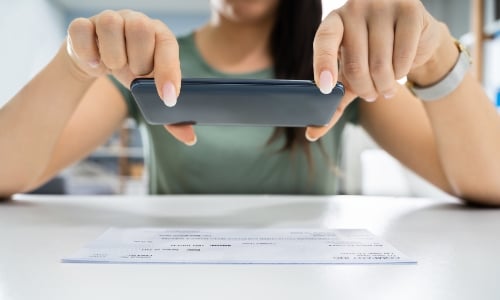Tips for mobile check deposit

Mobile check deposit is arguably one of the greatest technological banking innovations in recent history. As long as you have a smartphone with a data connection and have downloaded the correct app, you no longer have to physically head to a bank to deposit a check.
For the individuals who are always on the move and rarely have time to stop at a bank or ATM, mobile deposit is a feature that is more than helpful. The ability to deposit your check typically takes less than two minutes and allows you to keep your day moving without having to plan for a trip to the bank.
However, as often the feature works, there are instances where you may experience difficulty getting the right picture so the check is approved. As easy it is, mobile check deposit can sometimes have little quirks of which you need to be aware. Doing so will make the process even smoother.
Update your phone and mobile application
Even though operating a smartphone has become much easier over the years, you still have to remember some of the more technical aspects of it, such as regular updates that come out. Your phone's manufacturer will release software updates that improve some internal aspects, such as camera quality.
Manufacturers will have two types of updates for their smartphones: incremental and major. The incremental updates come out every few months while the major updates are released yearly. It's important to update because over time, some apps, including your bank's, may not work with older versions of a phone's software.
As such, you will want to ensure you are always checking for updates on a consistent basis. Your device may even have a feature for automatic updates.
Next up is to make sure you update your app by seeing if new versions are available in your phone's app store. Again, they may introduce some new features and updates that not only improve the mobile deposit experience, but may even make it easier.
Picture reminders
With every new year comes a new smartphone from the world's largest companies, and that includes a better camera. Enhanced camera quality helps take sharper photographs without having to wait for the image to focus, but in most instances, you can point your phone at the check and expect a decent photo.
But some issues may arise with your photo quality. To help alleviate them, always make sure you're taking a picture of the check while it's on a table with a dark background - never hold it in your hand. Ensure that only the check is in the frame and nothing else, as this can cause confusion within the banking app.
Lighting is also an important factor because you want to try to avoid having shadows cast over the check. Darker photos may obscure important information and cause the deposit to be rejected.
If you can, try to place the check on a dark background. Paperwork that is lighter in color will cause issues if placed on white surfaces.
Check your connection
If you've done all the above and still find your deposit is being rejected, it may be a sign that your signal is weak. Whether you're connected to Wi-Fi or cellular, you need a strong signal to send deposit the check.
All phones will display this information near the top, and it is typically represented by bars of varying length. Wait until they all light up to try the deposit again.
With smartphones, banks now allow checks to be deposited through mobile services. To ensure the transaction is not muddled with issues, keep your phone updated and focus on taking quality pictures.
[1]. Mobile Check Deposits: Pro Tips to Ensure They Go Smoothly